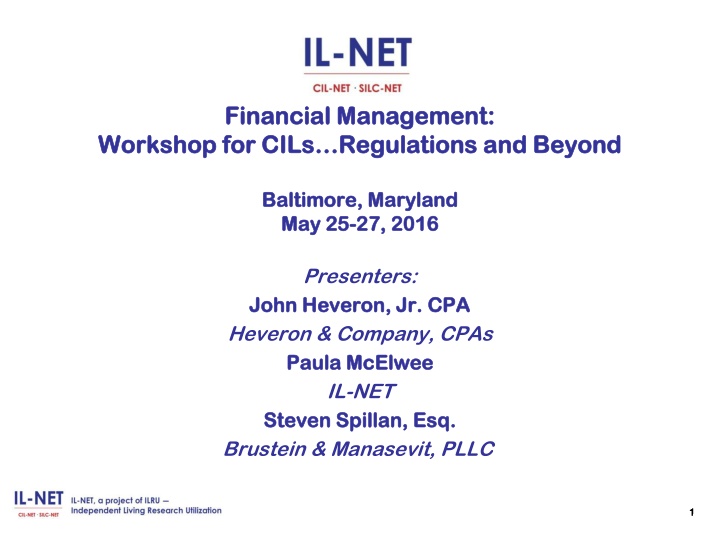
Lobbying Regulations for Charities and Nonprofits
Explore the intricacies of lobbying regulations for charities and nonprofits, including what activities are permitted and prohibited, the difference between advocacy and lobbying, and the IRS rules regarding lobbying. Gain insights into direct lobbying, grassroots lobbying, and allowable activities as defined by the Uniform Guidance. Stay informed on how to navigate the complex landscape of influencing legislation while ensuring compliance with federal guidelines.
Download Presentation

Please find below an Image/Link to download the presentation.
The content on the website is provided AS IS for your information and personal use only. It may not be sold, licensed, or shared on other websites without obtaining consent from the author. If you encounter any issues during the download, it is possible that the publisher has removed the file from their server.
You are allowed to download the files provided on this website for personal or commercial use, subject to the condition that they are used lawfully. All files are the property of their respective owners.
The content on the website is provided AS IS for your information and personal use only. It may not be sold, licensed, or shared on other websites without obtaining consent from the author.
E N D
Presentation Transcript
Financial Management: Financial Management: Workshop for CILs Regulations and for CILs Regulations and Beyond Workshop Beyond Baltimore, Baltimore, Maryland May 25 May 25- -27, 2016 27, 2016 Maryland Presenters: John Heveron, Jr. CPA John Heveron, Jr. CPA Heveron & Company, CPAs Paula Paula McElwee McElwee IL-NET Steven Spillan, Esq. Steven Spillan, Esq. Brustein & Manasevit, PLLC 11
Lobbying Lobbying What is Permitted and Prohibited What is Permitted and Prohibited CIL-NET, a project of ILRU Independent Living Research Utilization 2
Lobbying Rules for Lobbying Rules for Charities Uniform Guidance section 200.450 addresses lobbying, including lobbying activities which are unallowable costs, such as attempting to influence a federal employee regarding a federal award on any basis other than the merits of the matter. Identifies costs that aren t specifically unallowable such as nonpartisan analysis, research reports, and any activity specifically authorized by statute to be undertaken with federal awards. Lobbying is an activity that needs to be charged with indirect costs (and be identified in your indirect cost rate proposal). Charities 3
IRS Lobbying IRS Lobbying Rules for Advocacy is not lobbying although it can include lobbying. Advocacy can be any of a variety of activities with the objective of bringing about systemic social change. Advocacy can advance your cause & increase your visibility, & may or may not include lobbying activities. Advocacy can also include communicating with your legislators or the general public about helpful legislation without addressing specific legislation that is not lobbying. http://www.ilru.org/training/influencing-policy Rules for Charities Charities 4
IRS Lobbying IRS Lobbying Rules for Rules for Charities, Charities, cont d. cont d. Lobbying is attempting to influence legislation by Stating a position on specific legislation to legislators or other government employees who participate in the formulation of legislation (direct lobbying). Urging your members or the general public to contact their legislators with a position on specific legislation (a "call to action") (grassroots lobbying). Lobbying expenses include amounts for research, preparation, planning or coordination of any activity related to lobbying as well as direct lobbying costs. 5
IRS Lobbying IRS Lobbying Rules for cont d. cont d. 2 2 Uniform Guidance says that activities that are excluded from the definition of lobbying and influencing legislation by the Internal Revenue Code activities are allowable. Being allowable doesn t mean you necessarily have funding for them Charities exempt under IRS Code section 501(c)(3) have an option to register to come under a safe harbor which allows them to spend a certain percentage of their total expenditures on lobbying each year, although certain activities are prohibited. Rules for Charities, Charities, 6
IRS Lobbying IRS Lobbying Rules for Rules for Charities, Charities, cont d. 3 cont d. 3 501(h) Safe Harbor Registration Maximum lobbying expenditures are based on total expenditures as follows: 25% of the above amounts are allowable for grassroots lobbying 7
IRS Lobbying IRS Lobbying Rules for Political Parties and Candidates: Unlike lobbying, certain involvement with political candidates or political parties is strictly prohibited and can lead to revocation of your exempt status. Charities need to avoid supporting or opposing candidates for public office. Charities cannot allow paid employees to work on behalf of a candidate or political organization while receiving compensation. Campaigning AGAINST a candidate has the same effect as campaigning FOR one. Rules for Charities, Charities, cont d. 4 cont d. 4 8
IRS Lobbying IRS Lobbying Rules for cont d. 5 cont d. 5 Political Parties and Candidates: This prohibition also extends to contributions to candidates campaigns, engaging in fund-raising activities, distributing statements and similar activities. You cannot use organization resources for a candidate s golf tournament or fundraising event. You cannot allow a candidate or political organization to use your facilities or equipment. Watchdog organizations monitor nonprofits, informing the IRS about violations of the rules prohibiting involvement in political campaigns. Rules for Charities, Charities, 9
Resources on Lobbying Rules for Resources on Lobbying Rules for Charities Charities Additional information about lobbying guidelines can be found at www.independentsector.org. Look at the policy & advocacy tab of their website. This can be a one-stop shop for rules and requirements as well as advocacy skills and information on how to contact your legislators. 10
CIL CIL- -NET NET Attribution Attribution Support for development of this technical assistance information was provided by the Department of Health and Human Services, Administration for Community Living under grant number 90TT0001-02-00. No official endorsement of the Department of Health and Human Services should be inferred. Permission is granted for duplication of any portion of this information, providing that the following credit is given to the project: Developed as part of the IL-NET, an ILRU/NCIL/APRIL National Training and Technical Assistance Program. 11
